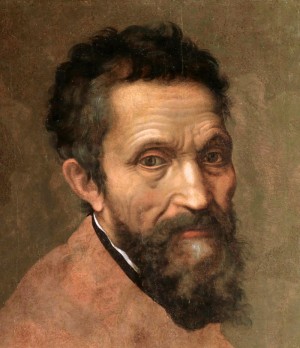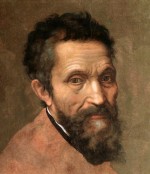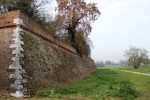Michelangelo Buonarroti on the walls of Ferrara
Among the many experts in military arts that visited the fortifications built by Alfonso I d’Este was none other than Michelangelo, who came to Ferrara in 1529 to study the city's large eastern bulwarks.
Not just Michelangelo
The fortifications built by Alfonso I d’Este along the south-eastern section of the city walls were soon admired among his contemporaries, especially architects and military engineers.
On 6 September 1518, Bernardino Prosperi, a Mantuan correspondent stationed in Ferrara, warned the Marchioness Isabella d’Este that:
In the hamlet below they're working to make ditches and mountains, that will be as tall as the palace in Ferrara and perhaps even more, for what one already understands, and each day the Lord [duke] goes there in the morning and stays to see and push for the work with carts and men, of which there are about 1,200. Then there are towers and walls that, as supplied as they are, this city could be tormented by artilleries and battles, but taking it would be incredibly difficult and almost impregnable (Marchesi 2015, p 458)
Alfonso was making Ferrara an impregnable city through surprising defensive solutions, to the degree that, just two years later, on 8 July 1520, Ferrante Gonzaga told his mother Isabella of his impressions standing before the large Baluardo della Montagna, which had the reputation of being the ‘most superb fortress in the world’. Duke Alfonso has gone down in history for his qualities as a princely architect and engineer, an expert in the invention and realisation of explosive devices and heavy weapons in particular. In Orlando Furioso (1516, XXV, 14), Ludovico Ariosto even mentions two of these pieces of artillery, the ‘Big Devil’ and the ‘Quake’ or ‘Earthquake’, named for the ‘inestimable impetus that it created’ and the ‘terrible boom and roar’, respectively. According to Paolo Giovio, one of these cannons had been made personally by the duke, ‘an excellent master in that art’. Alfonso's design and executive abilities in the field of war were celebrated, noting that in Ferrara, ‘they continuously forged his models in artillery factories of all kinds, according to his designs’.
He fabricated, with his admirable ingenuity, to be able to make a large quantity of gunpowder in a short amount of time, a machine turned by water, in which hung certain iron pestles, in turn each one hitting one or the other, in certain stacks of copper, pummelled with such brevity, coal, saltpetre and sulphur, that one boy who simply operated it did the work of a large quantity of men (Giovio 1553, p. 70).
The work of fortifying the city, as ordered by the duke, was particularly praised:
It seemed like a good idea to Alfonso to have his confederates, these enterprises, used up in this way, and plans of the Pope, to be entirely free of a dubious war, and near Ferrara, yet he never gave in to living idly; and he never failed to think about the trappings of war. In fact, to the contrary, having banned all fun and games, he continuously awaited the fortification of the city, expanding the walls, deepening and widening the ditches, and having made of land, amassing incredibly wide and tall wall walks of such size that anyone’s artillery could be placed upon them, to easily keep the enemies away and stop them from damaging the walls (Giovio, 1553, p. 59)
Even Michelangelo came to Ferrara in 1529 specifically to see the modern bastions that had just been built under the supervision of Sebastiano Bonmartini from Monselice, aka ‘il Barbazza’. According to Giorgio Vasari's Lives of the Artists, and the Lives by biographer Ascanio Condivi, the leaders of the Republic of Florence decided, at that time, to entrust Buonarroti with the new fortifications of the Tuscan capital and, in this regard, they
wished to send him to Ferrara on the pretext that he should study the method that Duke Alfonso had followed in arming and fortifying the city. For it was known that his Excellency was an expert in these matters and very prudent in everything. The duke received Michelangelo with a joyful countenance, because of the latter’s greatness and because his son, Don Ercole, his son, that state's present Duke, was captain for the Signoria of Florence. And, when he rode in person with Michelangelo, he showed him all the relevant items and more, from bastions to artillery. And he also opened up all his collection for him, showing him everything with his own hands, notably some works of painting and portraits of his ancestors, masterpieces, where were excellent for the age in which they were made (Farinella 2007, pp. 59-60).
Michelangelo stopped off in Ferrara in the months of August, September and November, staying with the student Antonio Mini (who at the time was 23 years old) and his friend, a goldsmith nicknamed il Piloto, at the Osteria dell'Angelo, in Via Ripagrande (today's A.S.P. Retirement Home). It is worth mentioning that, at that time, the Este duke could boast, among his pieces of artillery, the ultra-famous ‘Giulia’ culverin, made with part of the bronze taken from the toppled statue of Pope Julius II, forged by Michelangelo himself in 1507-1508 for the main entryway of the church of San Petronio in Bologna. Located in the fortifications of Reggio Emilia (where it was mentioned in a 1625 inventory as ‘old and poor in metal’), it weighed about three tonnes and shot cannonballs of 50 pounds: less than half of ‘the Great Devil’ and the ‘Earthquake’.
According to biographer Condivi, taking advantage of his presence in Ferrara, Duke Alfonso appealed to the Florentine artist in these terms:
Michelangelo, you are my prisoner. If you want me to let you go free, I want you to promise me to make me something by your own hand, as suits you, just as you wish, sculpture or painting.
Thus arose the promise to create a painting in ‘colourful tempera’ representing the carnal union of Leda, lying down, and Jupiter turned into a swan, based on a famous ancient model used for jewellery and seals. There was also an egg and a young Castor and Pollux. The painting, however, was far from fortunate. When delivered in October 1530, the work was completed, but the emissary from Ferrara, Iacopo Lachi (aka Pisanello), was quite tactless, calling it, in the presence of the artist, ‘not much’. Disrespected, Michelangelo then refused to deliver it. Condivi wrote, ‘the Duke's messenger was fired, and shortly after he gave the painting to one of his errand boys’. The piece, with a few drawings, was in fact handed over - perhaps as a gift, perhaps to be sold - to Antonio Mini, who took it to France in 1531. In 1532 it was left in the depot of King Francis I, who perhaps bought it later, for his castle in Fontainebleau. What happened next is uncertain: perhaps it was burned by the Jesuit François Sublet De Noyers, War Minister for Louis XIII or by his widow (Queen Anne of Austria) for moral reasons, or it was simply hidden. It seems that Milizia saw it ‘in poor shape’ in 1740, but it was never mentioned again after that. All that remains are some red pencil sketches on paper stored in Florence, and various prints and painted copies made from the original.
We also have no trace of Michelangelo's sketches of the city's defensive walls. However, the Prints and Drawings Department at the Uffizi Gallery has the sketches of the city's triangular ramparts made by Antonio da Sangallo the Younger during his exploration of Romagna in 1526 on behalf of Pope Clement VII.
Bibliography
- Paolo Giovio, La vita di Alfonso d'Este duca di Ferrara. Tradotta in lingua toscana da Giovambattista Gelli Fiorentino, [ed. or. Firenze 1553], Venezia 1597
- Christoph L. Frommel, The architectural drawings of Antonio da Sangallo the Younger and his circle: Fortifications, Machines, and Festival Architecture, vol. I, Architectural History Foundation 1994
- Vincenzo Farinella, “Non si poteva satiare di guardare quelle figure”: Michelangelo e Alfonso I d'Este, in Pina Ragionieri (a cura di), Michelangelo. La “Leda” e la seconda Repubblica fiorentina, Silvana Editoriale, Cinisello Balsamo (Mi) 2007
- Vincenzo Farinella, Alfonso I d’Este: le immagini e il potere. Da Ercole de’ Roberti a Michelangelo, Officina Libraria, Milano 2014
- Andrea Marchesi, Delizie d'archivio. Regesti e documenti per la storia delle residenze estensi nella Ferrara del Cinquecento, Tomo II, Dimore urbane, Le Immagini edizioni, Ferrara 2015
- Andrea Marchesi, Non solo Rossetti: Bramante e Sebastiano da Monselice (alias Barbazza) nella committenza architettonica di Alfonso I d'Este, in Andrea Marchesi, Marialucia Menegatti, «Grande così quanto forse ignorato»: omaggio a Biagio Rossetti, «Ferrariae Decus. Studi-Ricerche», 33, 2018
Fototeca
Related Themes
Compiling entity
- Assessorato alla Cultura e al Turismo, Comune di Ferrara



